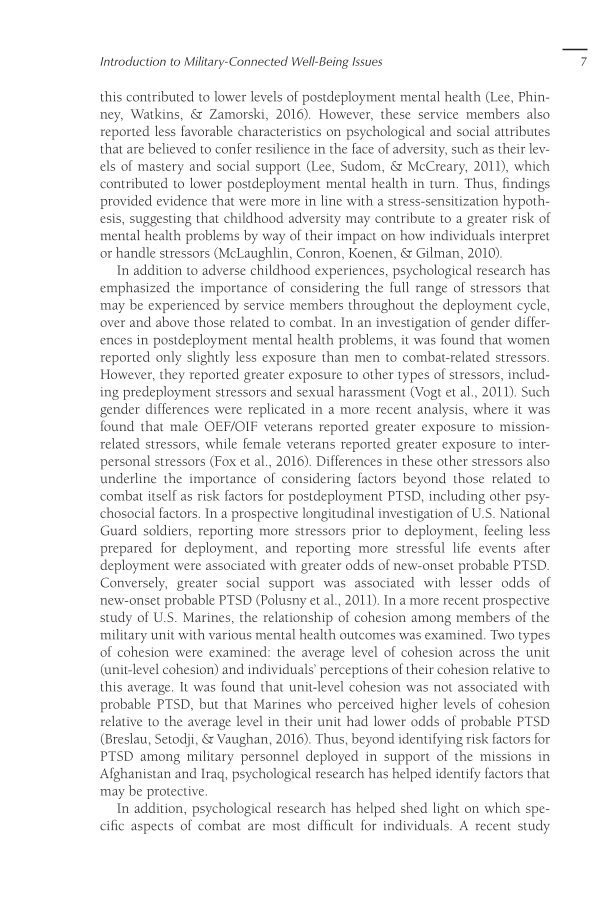Introduction to Military-Connected Well-Being Issues 7 this contributed to lower levels of postdeployment mental health (Lee, Phin- ney, Watkins, & Zamorski, 2016). However, these service members also reported less favorable characteristics on psychological and social attributes that are believed to confer resilience in the face of adversity, such as their lev- els of mastery and social support (Lee, Sudom, & McCreary, 2011), which contributed to lower postdeployment mental health in turn. Thus, findings provided evidence that were more in line with a stress-sensitization hypoth- esis, suggesting that childhood adversity may contribute to a greater risk of mental health problems by way of their impact on how individuals interpret or handle stressors (McLaughlin, Conron, Koenen, & Gilman, 2010). In addition to adverse childhood experiences, psychological research has emphasized the importance of considering the full range of stressors that may be experienced by service members throughout the deployment cycle, over and above those related to combat. In an investigation of gender differ- ences in postdeployment mental health problems, it was found that women reported only slightly less exposure than men to combat-related stressors. However, they reported greater exposure to other types of stressors, includ- ing predeployment stressors and sexual harassment (Vogt et al., 2011). Such gender differences were replicated in a more recent analysis, where it was found that male OEF/OIF veterans reported greater exposure to mission- related stressors, while female veterans reported greater exposure to inter- personal stressors (Fox et al., 2016). Differences in these other stressors also underline the importance of considering factors beyond those related to combat itself as risk factors for postdeployment PTSD, including other psy- chosocial factors. In a prospective longitudinal investigation of U.S. National Guard soldiers, reporting more stressors prior to deployment, feeling less prepared for deployment, and reporting more stressful life events after deployment were associated with greater odds of new-onset probable PTSD. Conversely, greater social support was associated with lesser odds of new-onset probable PTSD (Polusny et al., 2011). In a more recent prospective study of U.S. Marines, the relationship of cohesion among members of the military unit with various mental health outcomes was examined. Two types of cohesion were examined: the average level of cohesion across the unit (unit-level cohesion) and individuals’ perceptions of their cohesion relative to this average. It was found that unit-level cohesion was not associated with probable PTSD, but that Marines who perceived higher levels of cohesion relative to the average level in their unit had lower odds of probable PTSD (Breslau, Setodji, & Vaughan, 2016). Thus, beyond identifying risk factors for PTSD among military personnel deployed in support of the missions in Afghanistan and Iraq, psychological research has helped identify factors that may be protective. In addition, psychological research has helped shed light on which spe- cific aspects of combat are most difficult for individuals. A recent study
Document Details My Account Print multiple pages
Print
You have printed 0 times in the last 24 hours.
Your print count will reset on at .
You may print 0 more time(s) before then.
You may print a maximum of 0 pages at a time.































































































































































































































































































